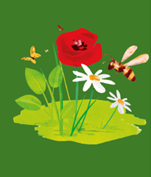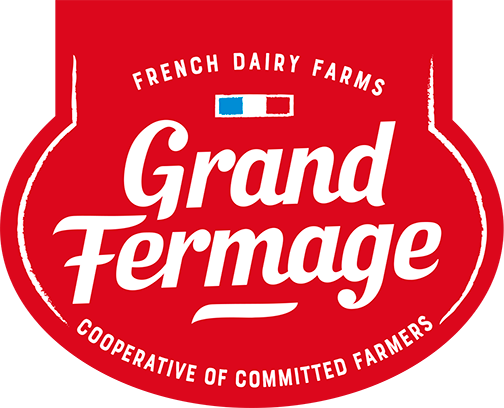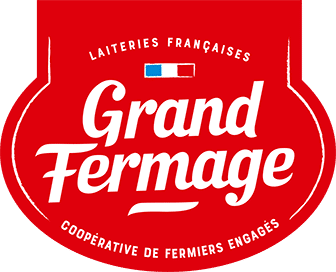Frequently asked questions
Our products
The Grand Fermage breadcrumbs is a coating made of wheat flour, rapeseed oil, sunflower oil, yeast, salt, spices (paprika, turmeric), wheat gluten, and water.
You can find further, more detailed information on the product page.
Our Sea Salt butter is made from sea salt crystals from the Île de Noirmoutier.
It is these small grains of salt which give the butter its delicious crunch, and provide it with that very particular, lightly iodised taste!
In our Salt Crystal butters Grand Fermage, we use salt from the salt marshes of the Île de Noirmoutier. These grains of salt are removed from the sea by the isle’s sauniers.
To find out more, you can visit AQUASEL’s website: they are a cooperative.
If you find a product in a shop which is past its use-by-date, take it directly to the manager or a till assistant.
The employees in your shop will inform us immediately.
The majority of our packaging is recyclable, and we are working towards 100% recyclable packaging. The paper packaging for our soft butter can be recycled, as can the cardboard case which covers our breaded Camemberts.
Regarding the aluminium packaging that covers our PDO butters, the packaging for our Moulé de Vendée, and the film which covers our breaded Camemberts : they should be thrown into your household waste.
As Grand Fermage bears recycling in mind with all its packaging, the brand’s aim is to work on the development of recyclable, recycled, or re-useable packaging throughout the coming years.
Removing cardboard from our packaging in July 2019 has made it possible to cut back on 168 tonnes of card, which equates to 4200 trees!
A fantastic gesture for our planet and for our campaigns.
In food, quality labels guarantee the origin of the products. They can be recognised on a European or national level.
Among these labels are PDO and PGI.
The name ‘Protected designation of origin’ (PDO) is a European label which guarantees that the product was processed and treated in a specified geographical location.
Our PDO butters follow the Charentes-Poitou PDO specifications: they are made in Charentes-Poitou with milk that is allowed to come only from this region.
Protected Geographical Indication (PGI), also recognised on a European level, is a sign which designates a product whose characteristics are linked to the geographical place in which at least its production, preparation or processing takes place. The PGI label has a strong link with the idea of local know-how.
Grand Fermage offers butters and cheeses made from conventional milk by farmers within the cooperative.
However, you can also find a range of organic butters among Grand Fermage’s products.
This range comprises :
They all carry the European Organic Agriculture logo, and are certified as such.
Organic agriculture guarantees production methods which are respectful to the environment and to the well-being of the animal.
This production method is based specifically on the non-use of synthetic chemicals, the non-use of GMOs, the recycling of organic materials, crop rotation and biological control measures.
All Grand Fermage products are manufactured using French milk, from our farmers, and also produced on French soil.
Our butters are in fact manufactured in our dairies:
- in Cesson-Sévigné in Ille-et-Vilaine (Brittany)
- in Bellevigny en Vendée (Pays-de-la-Loire and formerly Poitou-Charentes).
With regards to our breaded cheeses, they are coated in Crest in the Drôme, but the Camembert comes from Dangé-St Romain in the Centre.
Lactic ferments are bacteria who contribute to the transformation of the milk with the aim of making butter, cheese, or yogurt.
These bacteria change the sugar in the milk, the lactose, into lactic acid, which is where their name comes from. This changed is referred to as fermentation.
All our products are made from pasteurised milk.
The aim of pasteurisation is to destroy pathogenic germs; in other words, ones which make us ill.
It is really a food conservation process, consisting of heating it to a given temperature (between 62 and 88 °C) over a specified period of time, before rapidly cooling it, in order to eliminate a large number of micro-organisms and avoid the multiplication of the ones which remain.
Rennet is a coagulant, but not all coagulants are rennet.
Rennet is extracted from a part of the stomach of ruminants.
Coagulants can have different origins (vegetable, microbial).
Both make milk coagulation possible.
Grand Fermage products do not contain any additives, thickeners, stabilisers or emulsifiers.
They are guaranteed as preservative and palm-oil free, which gives them their authentic taste.
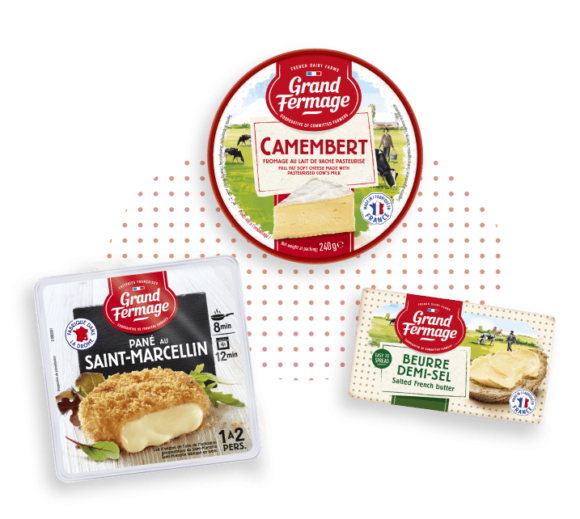
Nutritional information
We offer speciality butters and breaded cheeses. Our dairy products are made using cow’s milk, a foodstuff composed of proteins.
Our Grand Fermage breaded cheeses are sources of protein and can serve as an alternative to meat as the centrepiece of a meal.
The butters however only provide low levels of protein.
No, our range doesn’t offer lactose-free butter or cheeses.
Yes, Grand Fermage products contain allergens. These allergens are stated in bold type in the list of ingredients on the packaging of all our products.
The main allergen in our products is milk.
Other allergens, such as wheat, can also be present in the manufacturing process of some of our products, particularly the breaded cheeses.
Only products prepared with other ingredients than milk contain gluten. This is the case in, for example,our breaded Camemberts.
If a product contains gluten, the term ‘gluten’ or the allergenic ingredient (e.g. wheat) features in bold type on the packaging in the list of ingredients of the product in question.
All of Grand Fermage products, butters and cheeses, may be consumed by vegetarians.
It is recommended that children consume around 3 or 4 dairy products per day.
Indeed, dairy products provide calcium, which is essential for the formation and solidity of teeth and bones. Calcium is also involved in other vital bodily functions, such as muscular contraction, blood clotting and nerve conduction.
Products made with cow’s milk are therefore highly suitable for children, as long as they are not allergic. If your child is allergic, it is advised that you contact your doctor for a medical opinion.
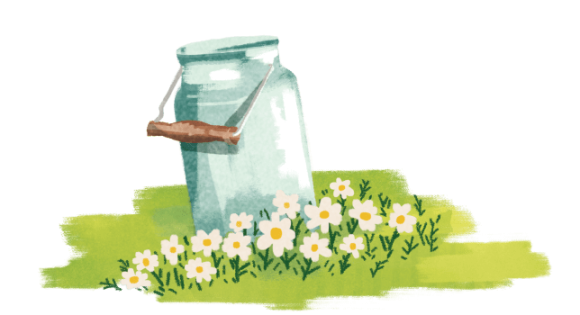
Our farmers and their farms
The Grand Fermage dairies have an average of 82 cows.
Some are grouped into GAECs (Groupement Agricole d’Exploitation en Commun) which are collective farming groupings developed so that the farmers can share equipment and skills.
Together we are stronger!
They are human-sized, family-run businesses. Often, several people work on the farm so as to provide the animals with all the care they need.
Whatever the size of the farm, the farmers maintain strong connections with their animals and animal welfare is an integral part of their’ work.
We should stress that the cows sometimes like to be indoors as well as grazing outdoors.
And at Grand Fermage, the farmers ensure their cows’ welfare both in the buildings and at pasture. As long as the grass is green outdoors, the cows like to go there to graze, but once the temperatures start to rise and the grass becomes scarce, they tend to chose to stay in the cool of their building.
Indeed, cows don’t sweat, and are therefore more sensitive to the heat than they are to the cold. Inside their building, they are sheltered from inclement weather and are fed with balanced portions which are less random than grazing on pasture.
The cows live in a covered, shared space. They can move about freely, access the trough or water points of their own free will and interact with other cows.
Often, the period they spend outside extends from March to October, following natural summer weather conditions.
Aside from the weather, the cows also need to come inside to be milked during their lactation period, and to ensure they are fed well.
Cows are herbivores
The herd may eat hay (dried grass), fresh grass, grass silage, corn silage, cereals (barley, wheat), nitrogenous pressed cake (colza, soya, flax…) supplemented with minerals, vitamins and trace elements.
Their ration is varied, balanced and at will in order to best meet their nutritional and satiety needs. While ensuring of course a healthy and balanced diet to obtain quality milk!
Depending on the type of farming, and in particular on the amount of grassland available, the farmer produces all or a large part of the fodder for his herd himself.
In France, on average, 93% of feed is produced on the farm (source: Observatoire de l’alimentation des vaches laitières in France, Farming Network 2011 and Institute of Farming) to feed the cows on the farm.
First of all, the cultivation of GMOs is forbidden in France and several European countries.
On average, more than 90% of cow feed (fodder, cereal) is produced on the farm, and 8% of other feed is produced in France and therefore are GMO-free.
However, France has a structural deficit in vegetable proteins, which are necessary for a balanced diet for cows. It therefore has to import vegetables like soybean cake. These imports may come from countries where regulations do not prohibit the cultivation of GMOs.
But alternatives in cow feed exist, such as rapeseed or linseed cake, which make it possible to substitute foreign soya.
After a 9-month gestation period, the calves are born on the farms. The cows have been prepared for 1 to 2 months prior to calving. This period is called drying-off.
Once the calves are born, it is advised that they are given colostrum within their first hours of life. They are then often placed in an individual area, for a maximum of 8 weeks. This space helps to protect the health of the calf and to control suckling and feeding
From the age of 8 weeks, the calves are raised together, according to regulation, so that they may express social behaviour with other individuals.
The heifers (females) are raised on the farm to ensure the regeneration of the herd.
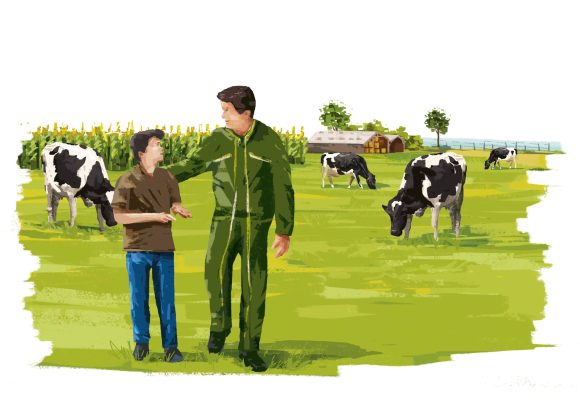
Can't find the answer to your question ?
Contact usTo go further ...
Our cooperative is run by our breeders!
A french cooperative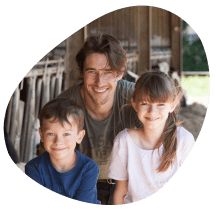
Our Grand Fermage farmers, creators of biodiversity!
Our CSR approach!